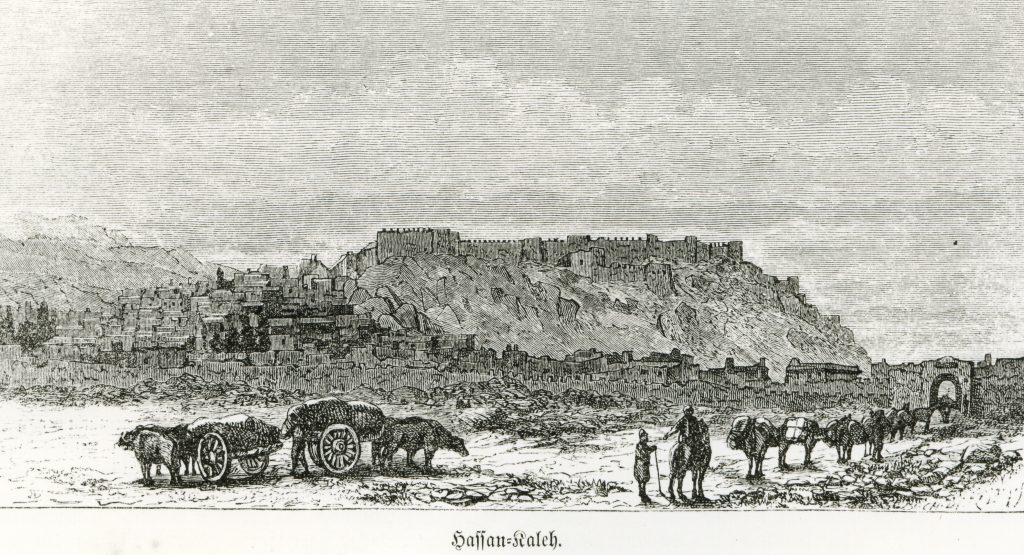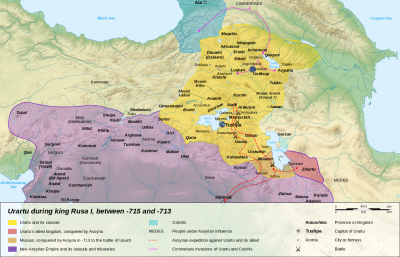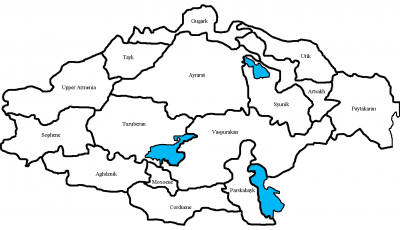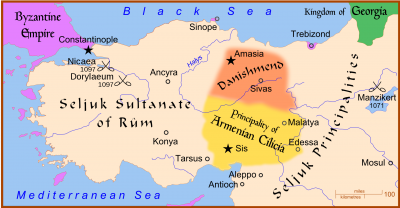
Located on the Arax (Araks; Trk.: Aras) River, Basen town is the site of Hasankale Castle. The area of Basen covers the western part of the ancient Armenian Ararat (Ayraratian) province. In ancient times, Basen covered a large area, including the entire Vanand province (Kars and Sarıkamış districts), which is called the Upper Basin. Later, this province was divided into Basen and Vanand, and then into separate ministries. Basin extended east of Karin (Erzurum), to the left of the Arax.
Toponym
One of several versions of the Pasinler toponym derives from an ancient tribe called Phasians (Phazians), another from the pheasants.
Formerly the town of Pasin was called Hasankale, or Hesenqele (‘fortress of Hasan’). The old name Hasankale could be based upon the Ak Koyunlu ruler Uzun Hasan or upon Hasan the governor of the region in the 1330s or after Küçük Hasan, grandson of Coban, who attacked the town in 1340.
Armenian Population
On the eve of the First World War there lived 16,740 Armenians in 57 localities of the kaza Pasinler, maintaining 16 churches, one monastery and 20 schools with an enrolment of 940 students.[1]
History
The first ancient kingdom which had a control of this territory is Urartu, who called itself Biaini. Based upon pottery finds, Basen was part of the Kingdom of Urartu during the Iron Age.
The territory of Basean belonged to Greater Armenia from 4th century B.C. to 5th century A.D. According to the Armenian historian Movses of Khoren (Khorenatsi; 5th century), this land was the family estate of the Armenian Vorduni dynasty, established by Armenian King Vagharshak, who ruled in 117 – 138/140 AD. In the day of the Arshakuni, the ministerial dynasty of the Vorduni was the hereditary domain. Their seat, together with that of the bishop of Basen was the settlement of Vordor or Vordr. The Vorduni had 700 cavalrymen and were in a protracted battle against the Manavazian ministry concentrated in Hark province. King Khosrov III Kotak (‘the Small’) tried to reconcile the warring parties, but in vain. Eventually, the case was handed over to Commander Vache Mamikonian, and he, with the sternness of a military man, abolished both ministries. After the massacre of the Vorduni, their lands passed to the bishop of Basen, a native of Vordor. The owner of Basen was later referred to as Judge Basen.(2) In the story of the Armenian historian Favstos Buzand (Faustos of Byzantium; 5th century), the thief of the Vorduni clan attacked the power of King Khosrov III Kotak, seizing and destroying the royal house, as a result of which the princes of the Vorduni clan were killed by order of Khosrov. After 428 A.D. this land became part of the Sasanian Armenia, right up to the Arab invasions in 7th-9th centuries. In the 9th century Basean belonged to Bagratid Armenia.
In the 10th century, the border between the Byzantine Empire and the expanding early Georgian Kingdom of Tao-Klarjeti went along the Arax river, therefore part of northern Basean/Basiani became a domain of the Georgian Bagratids. In 1001, after the death of David III of Tao (Kuropalates), Basean/Basiani was inherited by Byzantine Emperor Basil II, who annexed the Armenian lands (Tayk/Tao, Basean/Basiani), captured by King David Kuropalates to Byzantium and organized them into the theme of Iberia with the capital at Theodosioupolis (Erzurum) . However, after formation of the Georgian Kingdom, Bagrat’s son George I inherited a longstanding claim to David’s succession. While Basil was preoccupied with his Bulgarian campaigns, George gained momentum to invade Tayk/Tao and Basean/Basiani in 1014, which caused unsuccessful Byzantine-Georgian wars. Despite the territorial losses to Basil II, many of the territories ceded to the Byzantine empire were conquered by the Seljuk Turks in the 1070s-1080s, but were then retaken by the Georgian King David IV. In the 13th century, at Battle of Basian, Georgians defeated the army of the Rum Sultanate. The province was part of the united Kingdom of Georgia as an ordinary duchy till 1545, when Basiani was conquered by the Ottoman Empire. The Ottomans made Hasankale the centre of a sancak and entirely rebuild the citadel.
During the 19th century, several Russo-Ottoman wars took place in this region and had as a consequence that many Armenians emigrated from this region towards Russian held territory in Transcaucasia (South Caucasus).
Destruction
When the First World War broke out the Russians advanced to the plain of Pasinler but quickly retreated together with many of the local Armenian population. Some 4,000, however, remained and were deported. Between 1915 and 1917 the area was re-occupied by Russia. The Ottoman army regained control of the town on 13 March 1918.[3]
“(…) the rural areas of the vilayet of Erzerum were emptied of their Armenian population well before the cities. Most of the population of the sancak of Bayazid found refuge in the Caucasus, whereas the last villages of the Pasın district began to be ‘displaced toward the interior’ late in March [1915]. However, the towns and villages in Pasın lying near the Russian border that were evacuated in December 1914 or January 1915 were not spared atrocities. Half of the livestock (800 sheep, 1,400 cows, and 230 water buffalo) belonging to the villages of Khosroveran, where 40 families earned a living mainly from animal husbandry, were seized during the military requisitions in fall 1914 without the compensation provided for by the law. Eleven men were massacred during the Turkish army’s retreat, the Mgrdichian family was Islamized, seven people were killed while fleeing toward the Russian border, and five children were abandoned en route. In the neighboring village of Ishkhu, where 1,100 Armenians lived before the war, 70 percent of the community’s livestock (2,600 cows and 2,700 sheep) was confiscated to meet the army’s needs at the very outset of the mobilization. The village also contributed 45 conscripts and 20 to 30 porters to the war effort; the porters carried supplies to the front on their backs. Moreover, 30 adults were massacred on the spot during the January 1915 debacle, another 45 people died on the way to the Caucasus, and eight children were abandoned along the way.”[4]


